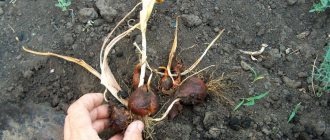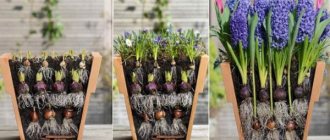Author: Natalya Category: Garden plants Published: January 22, 2019Republished: February 22, 2019Last edits: January 20, 2021
The best time for planting tulips is September and Indian summer, however, it is not always possible to carry out the procedure during this period: busyness usually interferes, and sometimes planting material falls into your hands too late and has already sprouted... What to do with tulip bulbs if Is it November already? Is it possible to plant them in soil that has already been frozen by frost? After all, everyone knows that both early and too late planting of tulips is undesirable. However, this issue is not so simple, and even in late autumn, flower growers still have a chance. Let's talk about this.
Choosing a place and preparing a bed
A good location of the bed and planting tulips in the fall, when and how to plant the choice will be less problematic.
These flowers love sunny spaces sheltered from the winds. In spring, no puddles should form there. The soil should drain well - the best option would be loamy or sandy loam soil with a significant proportion of humus. It is worth digging up the ground to a depth of 25-30 cm, carefully removing the roots of weeds, trees and shrubs. If the soil is heavy and poor, add sand and fertilizers: compost, ash, peat, mineral complexes. Cow manure should not be used - add bird droppings instead. If the pH values are increased towards oxidation, liming is required.
The soil needs to be prepared a month before the expected planting date. This is necessary for the soil to “settle.” In a loose “cushion” there is a high probability of damaging the emerging roots. Before planting, water the ridges generously - this will completely distribute the soil.
Usually this is where caring for tulips after planting in the fall ends. There is no need to cover the bed - this can lead to the bulb growing ahead of schedule, overwintering worse and blooming later. Exceptions include sudden cold weather. When the temperature drops sharply, use specialized covering material. Do not use garden waste, mulch or leaves as this may attract rodents.
How to plant tulips correctly, taking into account the depth and distance of planting?
Properly stored tulips will ensure healthy growth and beautiful flowering of plants in the future. Before planting in a flowerbed, planting material is carefully selected and processed. When choosing a place for a flower bed with tulips, give preference to sunny areas with good loose soil. Also add the necessary micronutrients and substances for active growth.
What you need to consider for proper planting of tulips:
- The recommended planting depth for tulips ranges from 15 centimeters (to accurately calculate the depth, the height of the bulb should be multiplied by three);
- A competent approach to planting tulips involves placing larger bulbs in the center of the flowerbed, and smaller ones along the borders and sides. A composition planted in this way will look complete and aesthetic, while small plants will not be in the shade;
in the photo - the optimal distance when planting tulip bulbs is 6-10 cm
- The optimal distance for planting tulips is 10 centimeters for large bulbs, 6-8 centimeters for small bulbs. The need to maintain a gap between flowers allows the roots to develop more actively, due to which the plant receives more nutrients;
- Considering how to plant tulips correctly, when creating a multi-colored flower bed with different varieties, it is better to increase the distance between categories. This is done to facilitate further care and prevent re-grading;
- Prepared grooves spilled with water, the bulbs are placed flat bottom on the ground, no need to press;
- After planting the tulips, the grooves are covered with earth and the top layer of soil is leveled;
- Watering is carried out as needed; in the rainy autumn months you can do without it, just like in the spring. If the weather is hot and dry outside, it is recommended to moisten the soil.
Digging and storing bulbs
Tulips are dug up every year. Exceptions are baby bulbs, which remain in the ground for 2 years. Why is this needed: diseased specimens are discarded, appearance improves (flowers become larger), and the ability to produce children increases.
We invite you to familiarize yourself with Bonsai according to Feng Shui - meaning and placement rules
There are a number of rules for when and how excavation is carried out:
- Don’t miss the moment: you need to dig up tulips when the leaf is 2/3 dry. If you get the bulb early, it will not have time to accumulate the required supply for subsequent flowering. Late extraction is fraught with the risk that the maternal part will go deeper underground, and the children will separate from it. There is a high probability of missing or damaging planting material.
- Arm yourself with a bayonet shovel: you should stick it deep and with a “margin” around the edges so as not to damage the flowers.
- Change the bed every 3 years.
Now let’s learn more about how to store tulips before planting in the fall. The resulting nests must be divided, freed from husks, roots, and leaf residues. Then they are washed (if necessary), treated with antifungal treatment and dried. Before putting planting material into boxes, it is necessary to sort it by variety and sorting. Remove diseased specimens.
Successful planting of tulips in the ground in autumn depends on maintaining temperature and humidity conditions. The bulbs are stored in boxes without a lid, arranged in 2-3 layers. They need to be inspected periodically to remove rotting specimens. The storage temperature is gradually reduced: in July it is 23-25°, in August – 20°, in September – 17°. Failure to comply with temperature limits leads to the appearance of blind shoots on which a flower does not form.
If during the inspection you find rot or mold, you can try to save the tulips. If the mold spread is small, remove it with a dry cloth and sprinkle with ash. If the rotting is deep, cut off the affected part with a knife. Sprinkle the cut with ash or lubricate it with brilliant green.
Caring for tulips
Caring for flowers directly depends on weather conditions. During dry autumn, the place where the bulbs are planted is watered abundantly. Water should saturate the soil to at least 30 cm. After this, the soil should be mulched with peat. The height of the peat layer should not exceed 3 cm. To improve the development of the root system, flowers can be fertilized. This is best done in mid-October and ammonium nitrate: 15 grams per square meter of soil.
During frosts, the planting site is covered with spruce branches. This will protect the bulbs from rodents and save them from freezing. With the onset of spring, spruce branches are removed. In spring, tulips need to be fed with nitrogen fertilizer (50 grams x per 1 m2).
During growth, the plant needs several abundant waterings. Make sure that the soil is wet to the full extent of the tulip roots. Estimate that you should use approximately 40 liters of water per square meter per watering. Tulips for a bouquet are cut with only one, or maximum two, leaves, otherwise you will not collect good bulbs in the fall. Be sure to decapitate (cut off faded flowers).
To properly preserve the bulbs, follow these steps sequentially:
- Bulb heads removed from the ground must be carefully sorted immediately. Good ones should be put aside; those damaged by pests or diseases should be thrown away.
- Carefully place the bulbs in boxes or on a tray for ventilation. Do not place the plants tightly, try not to let them touch each other.
- Tulips should be left in the fresh air for several days. Do not expose the bulbs to direct sunlight, as this will harm them.
- After drying, remove the bulbs until next season.
Soil care
Good soil should have the following properties:
- sufficient moisture capacity;
- looseness;
- air capacity.
You can cultivate the soil using various fertilizing and fertilizers. You can buy them at any gardening store. Just remember that you cannot radically fertilize the soil if there are already plants in it. Choose a time when the soil is dormant and apply your choice of organic or inorganic fertilizer.
Temperature
Correctly chosen temperature is the key to successful forcing of plants, storing their bulbs and flowering.
The cold storage time for bulbs ranges from 3 to 7 months. At this time, physical processes occur that allow the flowering shoot to develop. If you shorten the cooling period, the flowers will grow with very short stems.
After the cold period, the bulbous heads are stored in a well-ventilated area. It is better to maintain the air temperature in the region of 15 - 17 degrees, air humidity should be 60-70 percent.
How to fertilize and feed
You can fertilize the soil with commercial compounds, purchasing them at any gardening center or store. Remember that radical fertilizing should be applied only to pre-moistened soil to avoid burns to the plant root system.
After applying dry fertilizer, it is necessary to water the post thoroughly. Water will help deliver fertilizer to the roots faster. It is good to fertilize with nitrogen, potassium and phosphorus during the appearance of buds. The proportion of fertilizer is 1/2/2. This will not only help strengthen the root system, but will also have a beneficial effect on the speed of growth of tulips.
Diseases and pests
The variegation virus is the biggest threat to flowers. The disease appears in the form of spots and stripes on the leaves and petals of the plant. Infected tulips cannot be treated; they will have to be thrown out, along with the soil in which it grew. The excavated area should be generously watered with manganese solution.
Fungal August disease is also considered a common disease. The disease manifests itself in the form of a bent stem, striped flowers and leaves dark spots on the bulb. It is better to remove the diseased plant, fill the hole with manganese solution and cover it with ash.
To prevent diseases, after digging up the bulbs, plant this place with marigolds, calendula or mustard. This simple method gives unmatched results.
The main plant pests include mole crickets, onion root mites, snails, and rodents. Do not forget to treat the bulbous heads with a manganese solution before planting. And don’t be lazy to inspect the flowers every day, collecting insects from them.
Practical advice for pest control. Dig a glass jar into the ground, filling it three-quarters full with water. Once in the jar, the insect will not be able to get out on its own and will die.
When to plant
The timing of planting is affected by soil temperature. In the fall, the groundwork is made for subsequent flowering, so it is important to plant the bulbs in the garden on time. For all processes to start, the soil must be no colder than 10° (the lower limit is 8°). You can check the data using a depth thermometer.
In different regions, the timing of planting in open ground is different. Thus, planting tulips in the fall in the Moscow region occurs from mid-September and throughout October. The hotter the region, the closer to winter the dates shift. If, during a pre-planting inspection, you notice that the bulb is ready to actively begin to grow, it makes sense to leave it for forcing (that is, plant it in a pot and keep it at home).
In other regions, which are characterized by more severe climatic conditions, the planting period is from the end of September to mid-October. If the autumn is hot, then they are planted until the beginning of November. For example, the optimal planting of tulips in autumn in Siberia falls on the 10th-20th of October.
Landing
The planting depth of tulips can be calculated based on the height of the bulb - 3 sizes. But today rodents easily penetrate to this depth, so it is better to bury valuable varieties 5 times the height of the bulb, and you can also sprinkle a handful of dry spruce needles on top of it.
Unfortunately, plastic baskets do not protect against rodents, because the standard ones are too low and are easily susceptible to mouse teeth. If you plant in baskets, you need to bury them in the soil 2-3 times the height of the container. All bulb plantings are well watered and always mulched with a layer of humus or peat.
We invite you to familiarize yourself with the 9 Best Sedatives – 2021 Rating
After the onset of stable frosts, spruce branches are thrown on top, and when snow falls at least 15 cm thick, paths are trampled around the plantings, compacting the snow cover. It would be a good idea to place poisoned bait for rodents in the garden.
What to do with hatched sprouts?
If there are few green leaves from the soil, then simply cut off the seedlings. Later in the season, the bulb produces additional leaf reserves. If there is significant green growth or buds have formed, action must be taken before the plant freezes. Add additional mulch and cover the planting area with cardboard boxes or plastic to protect the bulbs from frost.
Installing lighting under wall cabinets yourself: step-by-step guide
A living New Year's beauty in Yalta was dressed up with toilet paper
I spin it more and put it on for the holidays too. Recipe for juicy pickled carrots
If truly inclement weather is ahead, and the bulb has already “woke up” and even released a bud, cut off this arrow. At least the flower will please you in the vase. Whether the bulb itself will survive is a big question. In fact, they are quite cold-resistant. Even if you lose the entire top of the plant, the bulb will still be buried deep in the soil. She should come back to life next year.











